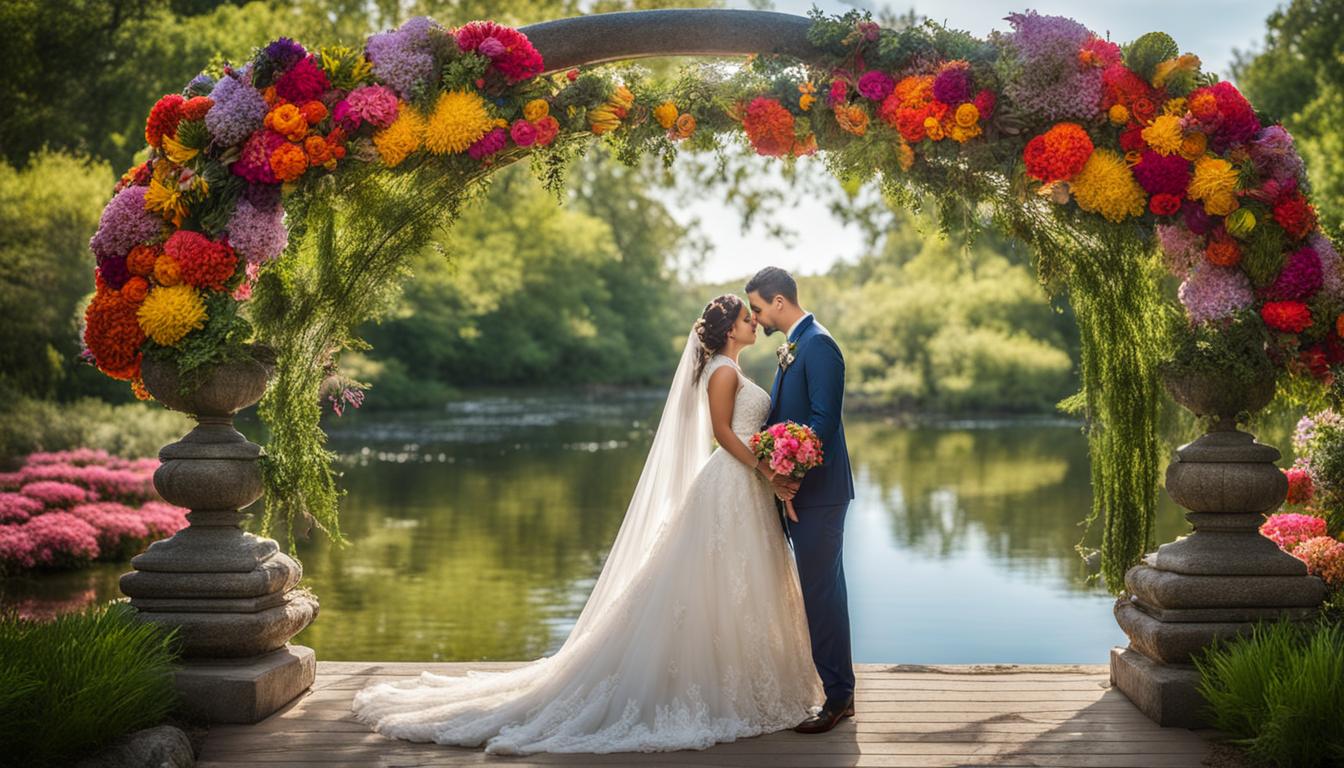When it comes to weddings, traditions and superstitions often play a significant role in shaping the celebrations. One such intriguing belief revolves around the symbolism of fish in marriage. Fish has long been considered a symbol of luck and prosperity in various cultures, including weddings. Let’s explore the fascinating customs and beliefs surrounding fish as wedding symbols.
Contents
- 1 Aiburobhaat – The Final Feast
- 2 The Ritual of Tattvo
- 3 Fish Motifs in Bengali Weddings
- 4 Significance of Fish in Bride’s Welcome Rituals
- 5 Fish in Global Wedding Traditions
- 6 Conclusion
- 7 FAQ
- 7.1 Is fish considered good luck for a wedding?
- 7.2 How is fish incorporated into the Aiburobhaat feast?
- 7.3 What is the significance of fish in the Gaye Holud ceremony?
- 7.4 How are fish motifs used in Bengali wedding customs?
- 7.5 What role does fish play in the bride’s welcome rituals?
- 7.6 Is fish used in wedding traditions around the world?
- 8 Source Links
Key Takeaways:
- Fish holds immense significance in Bengali weddings, where it is incorporated into various rituals and celebrations.
- The feast before the wedding, known as Aiburobhaat, features carefully selected fish preparations, symbolizing good luck and auspiciousness.
- During the Gaye Holud ceremony, a decorated Rohu fish is presented to the groom’s family, symbolizing good luck and prosperity for the bride.
- Fish motifs are used extensively in Bengali wedding customs, from the bride’s wedding sari to the decorations on sweets.
- Fish also holds importance in global wedding traditions, such as Chinese New Year festivities and the Feast of the Seven Fishes in Italian culture.
Aiburobhaat – The Final Feast
Aiburobhaat is a significant part of Bengali wedding rituals, serving as the final feast before the wedding day. This lavish affair is organized by the families of the bride and groom and involves the preparation and serving of various traditional Bengali delicacies. Amidst the array of food, fish takes center stage, playing a crucial role in adding auspiciousness to the upcoming marriage.
In the Aiburobhaat feast, fish is carefully selected, cooked, and served in different preparations. It is believed that the inclusion of fish in this grand feast brings good luck and prosperity to the couple. The presence of fish symbolizes abundance and fertility, which are essential in a successful marriage.
The Bengali culture deeply values the significance of fish in weddings, and the Aiburobhaat feast serves as a way to invoke blessings for the couple’s future together. Sharing a meal that incorporates fish allows the families to come together and celebrate the union of their loved ones in a joyous atmosphere.
To provide a glimpse of the scrumptious spread during the Aiburobhaat feast, here’s a table showcasing some popular fish dishes that are often served:
| Traditional Fish Preparations | Description |
|---|---|
| Machher Jhol | A light fish curry made with various spices that adds a burst of flavors. |
| Shorshe Ilish | A delectable dish made with Hilsa fish and a mustard-based sauce, creating a tangy and rich flavor. |
| Doi Maach | Fish marinated with yogurt and spices, cooked in a thick gravy for a creamy and satisfying dish. |
| Paturi | Fish fillets marinated in a mixture of mustard paste, coconut, and spices, wrapped in banana leaves, and steam-cooked to perfection. |
These fish delicacies are just a glimpse of the opulence and mouthwatering flavors that await at the Aiburobhaat feast. By incorporating fish into this final feast, Bengali weddings embrace their rich traditions and cultural beliefs, ensuring a prosperous and joyous beginning to the couple’s married life.
The Ritual of Tattvo
During the Gaye Holud ceremony, the bride’s family presents a large decorated Rohu fish to the groom’s family. This fish symbolizes good luck and prosperity for the bride as she embarks on her new journey. It is a gesture of extending wishes for her happiness in her married life. The fish is dressed up as a bride and plays a significant role in this pre-wedding ritual.
The Gaye Holud ceremony, also known as the turmeric ceremony, is a traditional Bengali wedding ritual celebrated with great joy and enthusiasm. It is a special occasion where the bride and groom are adorned with turmeric paste, signifying purification and blessings for their upcoming union. The centerpiece of this ceremony is the decorated fish, which holds deep symbolic meaning.
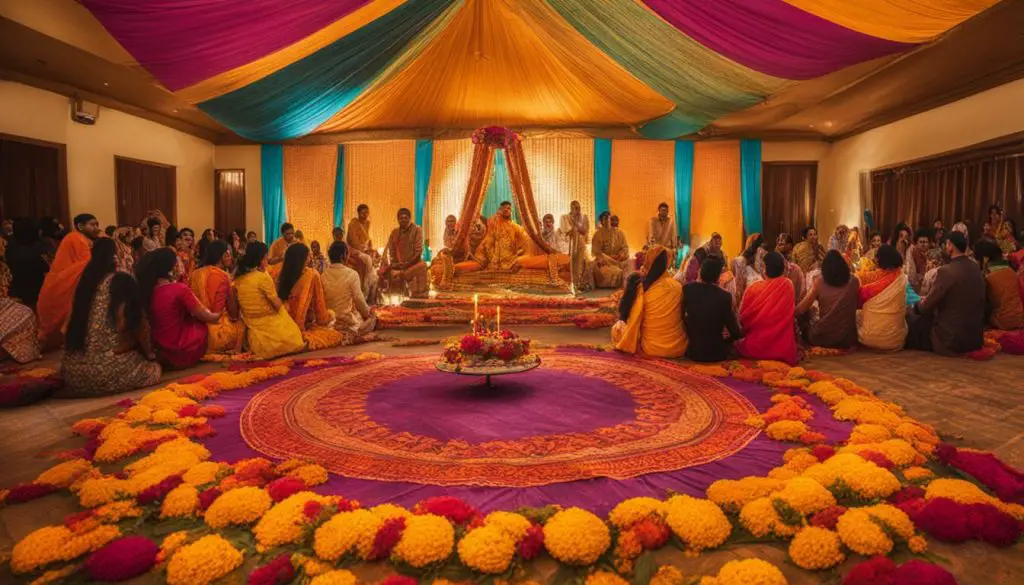
The fish used in the Gaye Holud ceremony is usually a Rohu fish, which is a species commonly found in rivers and lakes of Bengal. It is considered auspicious and is believed to bring good fortune and prosperity to the couple. The fish is decorated with colorful ornaments, beads, and flowers, resembling a beautiful bride.
This ritual not only adds a touch of beauty to the ceremony but also serves as a reminder of the importance of blessings and well-wishes in a marriage. The fish, symbolizing luck and abundance, is a way for the bride’s family to bestow their blessings and hopes for a happy and prosperous married life for the couple. It is a heartfelt gesture that showcases the rich cultural heritage of Bengali weddings and the significance of fish in the celebration of love and union.
Fish Motifs in Bengali Weddings
In Bengali weddings, fish motifs are prominently featured in various customs and traditions, symbolizing luck and prosperity for the couple. These motifs hold deep cultural significance and add a touch of tradition and symbolism to the wedding celebrations.
“The fish is a constant presence in Bengali weddings, appearing in the bride’s outfit, decorations, and even the food served during the festivities,” says wedding planner Aparna Das. “It is believed that fish brings good luck and blessings to the couple, ensuring a happy and prosperous married life.”
The use of fish motifs can be seen in different aspects of the wedding. The bride’s wedding sari is often draped in a style that resembles a fish, creating a visually stunning and symbolic ensemble. Additionally, when guests bring sweets as gifts, they are often shaped like fish, further emphasizing the significance of this marine creature in the festivities.
The inclusion of fish motifs in Bengali weddings showcases the rich cultural heritage and beliefs associated with marriage. It serves as a beautiful reminder of the enduring traditions passed down through generations and adds a unique and meaningful touch to the wedding celebrations.
| Fish Motifs in Bengali Weddings | Symbolism |
|---|---|
| Bride’s Wedding Sari | The sari is draped in a way that resembles a fish, symbolizing luck and prosperity for the couple. |
| Sweet Decorations | Sweets shaped like fish are often given as gifts, representing the blessing of a happy and prosperous married life. |
| Decorations | Fish motifs are incorporated into decorations, such as mandap designs and table centerpieces, to symbolize abundance and blessings. |
The presence of fish motifs in Bengali weddings adds a unique and charming element to the celebrations. From the bride’s attire to the decorations and even the food, these motifs serve as a visual representation of the couple’s hopes and wishes for a happy and prosperous married life.
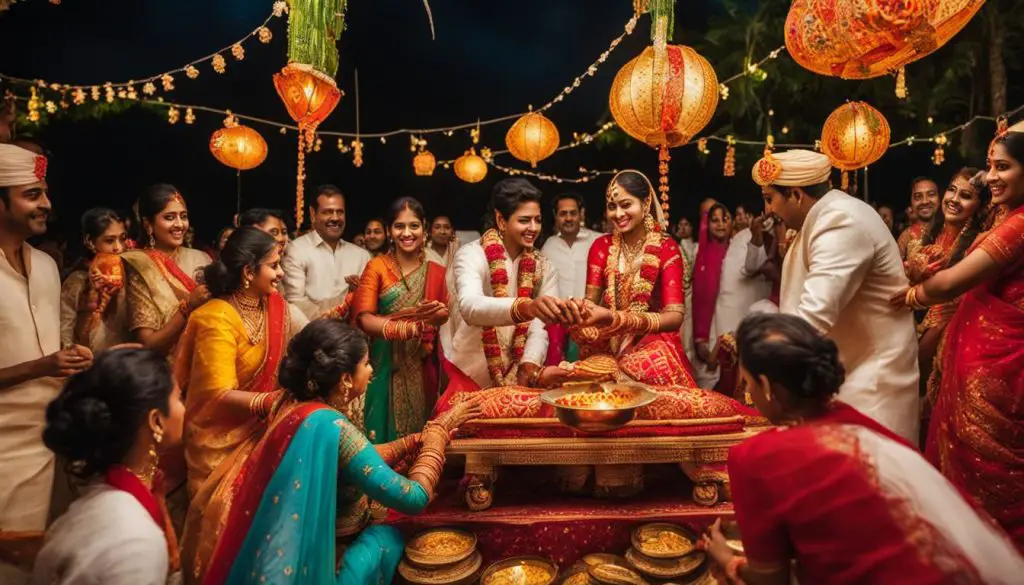
Significance of Fish in Bride’s Welcome Rituals
In Bengali wedding traditions, the arrival of the bride into her new household is marked by a special ritual that involves the presentation of a decorated fish. This ritual holds great symbolic meaning and is considered an auspicious start to the bride’s married life in her new home.
The fish, adorned with intricate decorations, is shown to the bride as she enters the house. This act signifies the importance of fish in Bengali culture and the belief that it brings prosperity and good fortune to the bride’s new life.
This tradition highlights the deep connection between fish and marriage in Bengali weddings. Fish not only represents luck and blessings but is also seen as a symbol of fertility and abundance, qualities that are desired for a successful marriage.
“The decorated fish is a significant part of our wedding rituals. It is believed to bring good luck and prosperity to the bride’s new household,” says Sunita, a Bengali bride.
By incorporating this ritual into their wedding celebrations, Bengali couples honor their cultural heritage and embrace the symbolism associated with fish. The significance of the fish in bride’s welcome rituals adds a touch of auspiciousness and tradition to the beginning of their married life together.
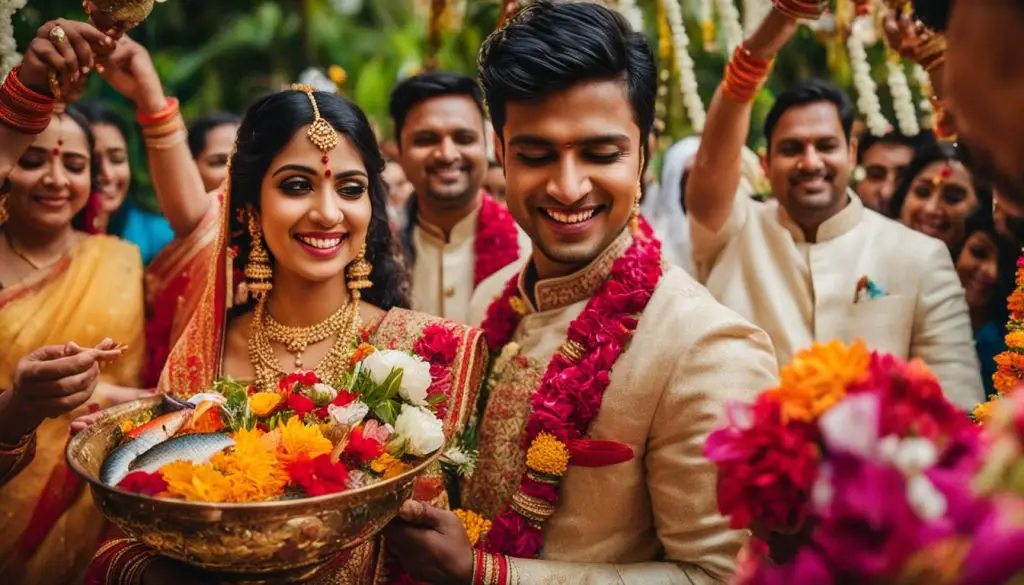
| Symbolism of Fish in Bride’s Welcome Rituals | Bengali Wedding Traditions |
|---|---|
| Luck and Good Fortune | In Bengali culture, fish is believed to bring luck and good fortune to the bride’s new household. |
| Fertility and Abundance | Fish is seen as a symbol of fertility and abundance, qualities desired for a successful marriage. |
| Cultural Significance | The ritual of presenting a decorated fish to the bride showcases the deep-rooted cultural traditions and beliefs of Bengali weddings. |
Fish in Global Wedding Traditions
Fish holds a symbolic place in wedding traditions not only in Bengali culture but also in various customs around the world. This aquatic creature is seen as a harbinger of good luck, prosperity, and blessings for the couples embarking on their marital journeys. Let’s explore how fish is incorporated into weddings in different cultures.
Chinese New Year: Fish as a Wish for Abundance
In Chinese culture, fish symbolism is prevalent during the Lunar New Year celebrations. The Chinese word for fish, “yú,” sounds similar to the word for abundance. As a result, fish decorations and dishes are often seen as wishes for a prosperous year ahead. One popular tradition is to serve a whole fish, symbolizing unity and completeness, as a centerpiece during the New Year’s feast.
“The presence of fish in Chinese weddings represents wealth and abundance, ensuring a prosperous start to the couple’s married life.”
The Feast of the Seven Fishes: A Delicious Italian Tradition
In Italian-American culture, the Feast of the Seven Fishes is a cherished Christmas Eve tradition. This culinary extravaganza features an array of seafood dishes, including various types of fish like cod, salmon, and shrimp. The number seven is believed to represent the seven sacraments of the Catholic Church. Each fish dish served during this feast symbolizes a different aspect of spirituality and blessings for the family.
Other Fish Symbolism in Weddings
Fish symbolism can also be found in other cultures. In Japan, koi fish is associated with love, friendship, and devotion, making it a popular motif in wedding decorations. In Scandinavia, fish-shaped cakes called “brudlaupskling” are served at weddings to bring good luck to the couple. These examples highlight the universal appeal of incorporating fish into wedding traditions.
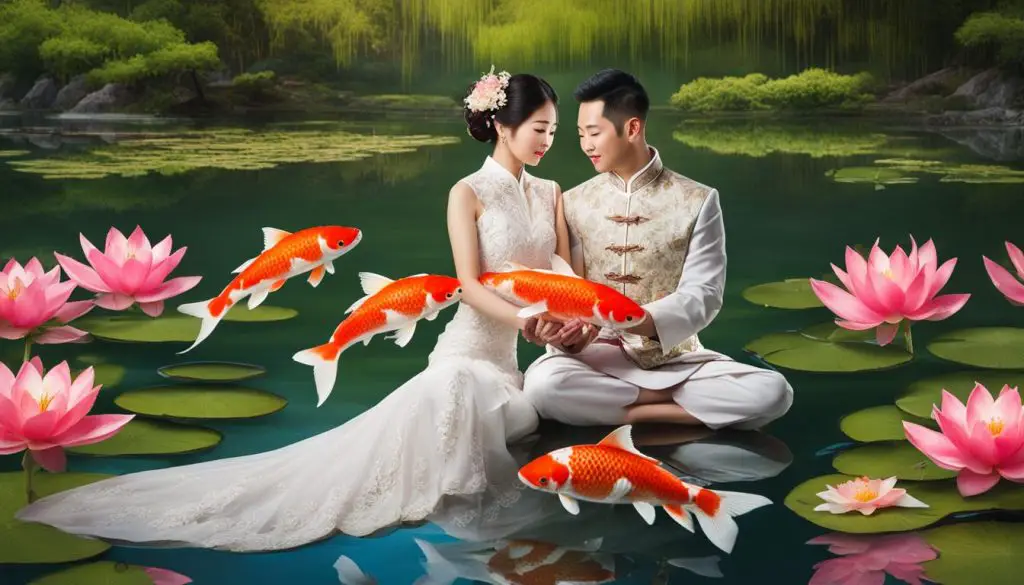
Table: Fish Symbolism in Global Wedding Traditions
| Culture | Fish Symbolism |
|---|---|
| Chinese | Wish for abundance and prosperity |
| Italian-American | Spirituality and blessings |
| Japanese | Love, friendship, and devotion |
| Scandinavian | Good luck for the couple |
As seen in these wedding traditions, fish serves as a powerful symbol of good fortune, unity, and blessings for couples worldwide. Embracing this symbolic creature in wedding rituals adds depth and meaning to the celebratory occasion and connects couples to age-old traditions spanning different cultures.
Conclusion
The symbolic presence of fish in wedding customs holds a significant meaning across cultures. It is particularly prominent in Bengali weddings, where fish is believed to bring luck, prosperity, and blessings to the couple. This deep-rooted connection between fish and marriage adds an intriguing twist to wedding celebrations, infusing them with symbolism and meaningfulness.
From the elaborate feast before the wedding to the bride’s welcome rituals, fish plays a pivotal role in Bengali wedding traditions. The fish motifs used in various customs, the decorated fish presented during the Gaye Holud ceremony, and the ceremonial significance of fish in the bride’s new household all exemplify the belief in fish as a symbol of luck and auspiciousness.
However, fish symbolism in weddings extends beyond Bengali culture. In Chinese New Year festivities, fish symbols represent abundance and prosperity for the year ahead, while Italian traditions feature the Feast of the Seven Fishes with multiple seafood dishes. These global customs highlight the universal association of fish with good luck and blessings in matrimony.
By embracing these age-old traditions, couples can infuse their special day with the symbolism and meaningfulness associated with fish. Incorporating fish into wedding customs is a unique way to bring luck and prosperity to their new journey together, adding a touch of charm and fascination to their wedding experience.
FAQ
Is fish considered good luck for a wedding?
Yes, fish holds immense significance in various wedding traditions, including Bengali weddings, where it is believed to bring luck and prosperity to the couple.
How is fish incorporated into the Aiburobhaat feast?
Fish is carefully selected and cooked as part of the traditional Bengali delicacies served during the Aiburobhaat feast, which takes place a day before the wedding.
What is the significance of fish in the Gaye Holud ceremony?
In the Gaye Holud ceremony, the bride’s family presents a decorated Rohu fish to the groom’s family as a symbol of good luck and prosperity for the bride’s married life.
How are fish motifs used in Bengali wedding customs?
Fish motifs are used in various ways, such as wrapping the bride’s wedding sari in a fish-like manner and decorating sweets in the shape of fish when sent as gifts.
What role does fish play in the bride’s welcome rituals?
One of the first rituals when the bride enters her new household is showing her a decorated fish, which marks the auspicious start of her married life in the new household.
Is fish used in wedding traditions around the world?
Yes, fish holds significance in various wedding traditions globally, such as Chinese New Year festivities and the Feast of the Seven Fishes in Italian culture, where it symbolizes luck and blessings for the couple.

